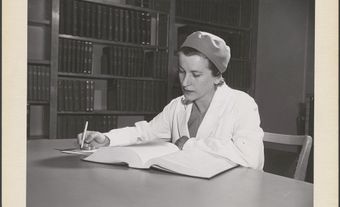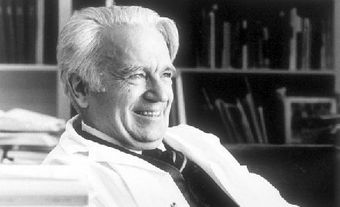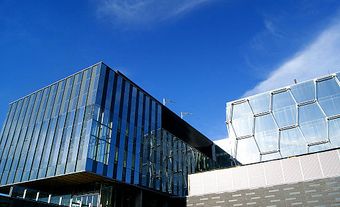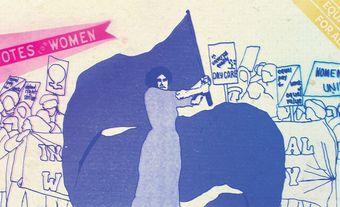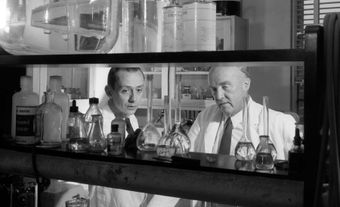Donna Theo Strickland, CC, physicist (born 27 May 1959 in Guelph, ON). Donna Strickland is a pioneering physicist, known for her work on ultrafast lasers. She is currently a professor of physics at the University of Waterloo. She has authored more than 90 publications and has made seminal contributions to the field of laser technology. In 2018, Strickland was jointly awarded the Nobel Prize in Physics for her work on the development of laser technology.

Early Life and Education
Donna Strickland was born and raised in Guelph, Ontario. Her father was an electrical engineer with General Electric, and her mother was an English teacher at Guelph Collegiate Vocational Institute, where Donna went to high school.
Strickland decided to enroll in an undergraduate program in engineering at McMaster University in Hamilton, Ontario, after learning about the option to study lasers there. She reflected on this decision in a 2018 interview with the Toronto Star: “I can’t do music, art, so there was not a lot of choice for me. I think people should go with their strength, and that was my strength.” Strickland earned her Bachelor of Engineering degree in physics in 1981 from McMaster, where she was one of only three women in a class of 25.
She went on to complete her doctorate in physics in 1989 from the University of Rochester in New York State. During her doctoral studies, Strickland worked in the laboratory of French physicist Gérard Mourou, where she developed the chirped pulse amplification technique, which allowed her to create what was, at the time, the most intense laser light ever generated. In 1985, Stickland and Mourou authored the seminal paper that would later win them the Nobel Prize in Physics, entitled “Compression of amplified chirped optical pulses.” The report has been cited over 4,500 times.

Research Career
Donna Strickland has held several research positions throughout her career and has made several important contributions to the field of laser technology. She first joined the National Research Council in Ottawa as a research fellow from 1988 to 1991, while finishing her doctoral degree. She then went on to hold staff scientist positions at the Lawrence Livermore National Laboratory in California from 1991 to 1992 and at Princeton University’s Advanced Technology Center for Photonics and Opto-electronic Materials from 1992 to 1996.
Since 1997, Strickland has taught and researched in the Department of Physics and Astronomy at the University of Waterloo. She leads the Ultrafast Laser Group Laboratory, which develops high-intensity ultrafast lasers, building upon the same chirped pulse amplification technique she developed during her doctorate.
Did you know?
The pulses developed by Strickland’s group can contain multiple wavelengths (or colours) of light and can approach the duration of a single femtosecond — that is one quadrillionth, or one millionth of one billionth, of a second.
Her group has also focused on developing self-focusing lenses, as well as studying how lasers interact with different types of lenses. This work aims to improve the elasticity of the lens of the human eye to eventually treat ophthalmic disorders such as presbyopia — the loss of up-close vision that affects many people with age.
Strickland was awarded the prestigious Alfred P. Sloan Fellowship in 1998 for outstanding early-career research in the sciences. She is actively involved in the Optical Society of America (OSA), having served as its director at large from 2005 to 2007. She is also the current chair of its Presidential Advisory Committee and was named a Fellow of the OSA in 2008.
Laser Legacy and Nobel Prize in Physics

The types of lasers that Donna Strickland has helped to develop have many medical applications, in addition to their importance in optical research. Ultrashort pulsed lasers are critical in the manufacturing of small, precise medical devices such as the stents used to inflate obstructed arteries. They are also used to make precise incisions in corrective laser eye surgery and cataract surgeries, where ultrashort pulses are necessary to prevent tissue from burning.
On 2 October 2018, Strickland was jointly awarded the Nobel Prize in Physics for the production of high-intensity, ultrashort optical pulses. She shares the award with her doctoral supervisor, Gérard Mourou, and American Arthur Ashkin of Bell Laboratories. In the 1970s, Ashkin independently developed the method of “optical tweezers,” the use of laser beams to trap and move objects as small as individual particles.
Strickland was the third female in history to win the prize and the first in 55 years, after Marie Curie in 1903 and Maria Goeppert Mayer in 1963. In an interview with NobelPrize.org, Strickland expressed that her immediate response upon hearing the news was that it might be a prank. She remarked, “I sort of feel like I just lucked into this whole thing… I’m glad there were trailblazers like her [Maria Goeppert Meyer] and Marie Curie … I think things have totally changed, so I think it will come around and change more.” Strickland had never sought full professorship prior to winning the Nobel Prize. In October 2018, she applied for and received a promotion to full professor at the University of Waterloo.
Canadian women and the Nobel Prizes
Donna Strickland is the second Canadian woman to win a Nobel Prize (after writer Alice Munro, in 2013), and the first Canadian woman to win in the sciences. Women continue to be underrepresented in the fields of science, technology, engineering and mathematics (STEM) in Canada, with particularly striking gender gaps in mathematics and physics.Test your knowledge of women in STEM in Canada by taking this quiz, offered by the Citizenship Challenge! A program of Historica Canada, the Citizenship Challenge invites Canadians to test their national knowledge by taking a mock citizenship exam, as well as other themed quizzes.
Personal Life
Donna Strickland is married to electrical engineer Doug Dykaar, with whom she has two grown children. The couple lives in Waterloo, Ontario.
Select Honours and Awards
- Research Fellowship, Alfred P. Sloan Foundation (1998)
- Premier’s Research Excellence Award, Government of Ontario (1999)
- Cottrell Scholars Award, Research Corporation for Science Advancement (2000)
- Fellow, Optical Society of America (2008)
- Nobel Prize in Physics, Nobel Foundation (2018)
- Companion, Order of Canada (2019)
- Honorary Fellow, Canadian Academy of Engineering (2019)
- Fellow, Royal Society of Canada (2019)
- Fellow, Royal Society (2020)
- Ordinary Member, Pontifical Academy of Sciences (2021)
- Knight, National Order of the Legion of Honour (2022)

 Share on Facebook
Share on Facebook Share on X
Share on X Share by Email
Share by Email Share on Google Classroom
Share on Google Classroom


